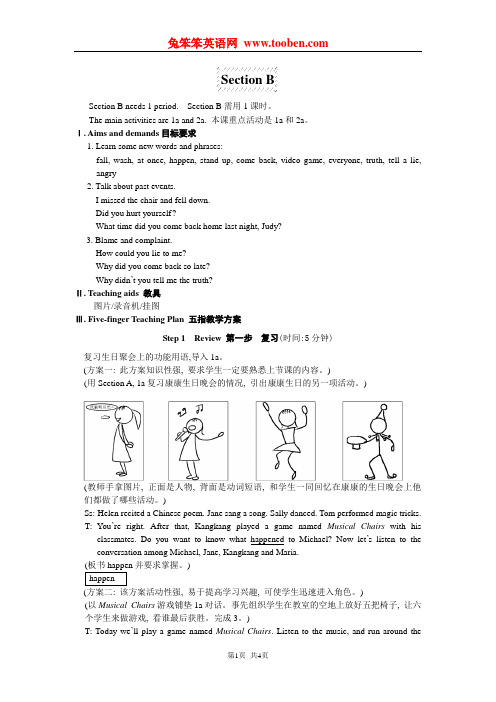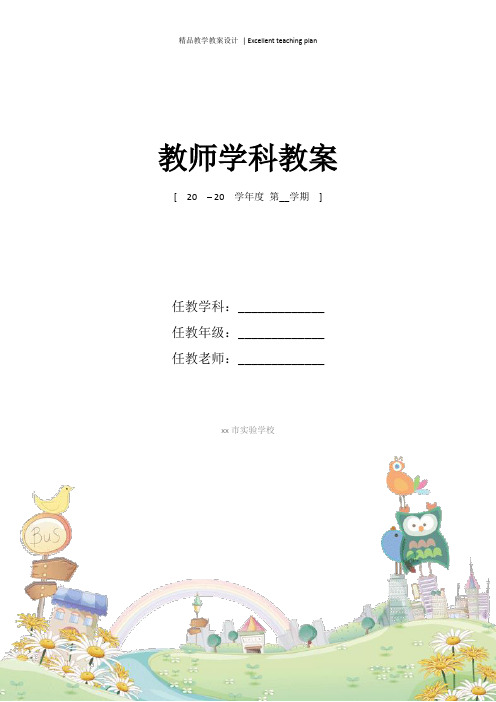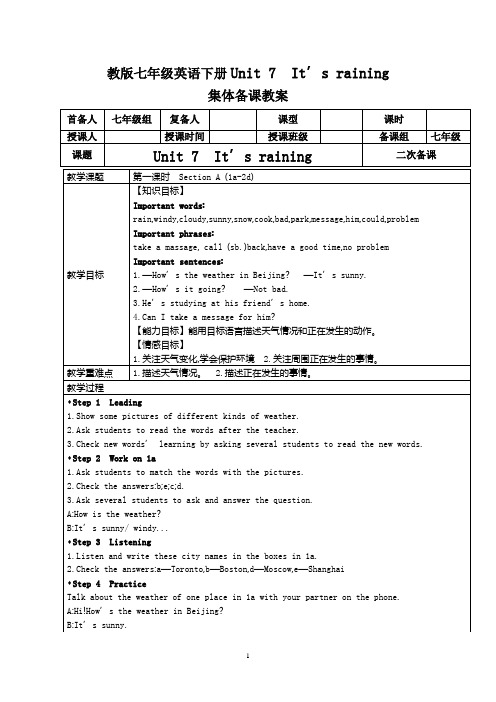Unit 7 Where are you Section B 教案新部编本
- 格式:doc
- 大小:91.50 KB
- 文档页数:4

Section BSection B needs 1 period. Section B 需用1课时。
The main activities are 1a and 2a. 本课重点活动是1a 和2a 。
Ⅰ. Aims and demands 目标要求1. Learn some new words and phrases:fall, wash, at once, happen, stand up, come back, video game, everyone, truth, tell a lie, angry2. Talk about past events.I missed the chair and fell down.Did you hurt yourself ?What time did you come back home last night, Judy?3. Blame and complaint.How could you lie to me?Why did you come back so late?Why didn ’t you tell me the truth?Ⅱ. Teaching aids 教具图片/录音机/挂图Ⅲ. Five-finger Teaching Plan 五指教学方案Step 1 Review 第一步 复习(时间:5分钟)复习生日聚会上的功能用语,导入1a 。
(方案一: 此方案知识性强, 要求学生一定要熟悉上节课的内容。
)(用Section A, 1a 复习康康生日晚会的情况, 引出康康生日的另一项活动。
)T: At Kangkang ’s birthday party. What did his friends do?(教师手拿图片, 正面是人物, 背面是动词短语, 和学生一同回忆在康康的生日晚会上他们都做了哪些活动。
)Ss: Helen recited a Chinese poem. Jane sang a song. Sally danced. Tom performed magic tricks. T: You ’re right. After that, Kangkang played a game named Musical Chairs with his classmates. Do you want to know what happened to Michael? Now let ’s listen to the conversation among Michael, Jane, Kangkang and Maria. 并要求掌握。

教师学科教案[ 20 – 20 学年度第__学期]任教学科:_____________任教年级:_____________任教老师:_____________xx市实验学校全国中小学“教学中的互联网搜索”优秀教学案例评选教案设计S1:Yes,I have.T: What do you think of it?S1: It is great and interesting.T: Yes.Every year,large numbers of tourists from different countries come to visit it,so it’s touristy.T:What about you? Have you ever been to the Great Wall?S2:No,I haven’t.T:Well,would you like to go there?S2:Yes,I’d love to.T:Why?S2:Because it’s famous.It reminds me of much history knowledge.T:Good.It’s very educational.Repeat the procedure with other pictures,teaching the new words: tiring , peaceful,fascinating and thring. Then read the new words together.Task ThreeShow the two posters in activity 1a.Ask students to describe them using the adjectives they have learnt.1、Work in groups of four and fill in the chart.2、Have a debate. Divide the whole class into two groups :The boys and The girls. The girls are for vacation 1 and the boys are for vacation 2.Task FourT:Now let’s listen to the tape.Where would Sam and Gina like to go on vacation? Why? Fill in the chart.Task FiveShow the following pictures:Hawaii, Mexico, Niagra Falls, San Francisco.Discuss the pictures in groups of four and say Where you would like to go and why. Plan your vacation.Task Six1、Look at the picture.Listen and number the sentences in order.2、Why do the four students decide not to visit these places? Listen and match the reasons.Task Seven1、Role play the conversation according to 2a and 2b.2、Write a passage according to 2a and 2b. Suppose you are a member of them, write something about their conversation. You can begin like this:We would like to visit Hawaii, because we like places where the weather is always warm, but it’s too touristy. …Task EightBeijing will be the host for 2008 Olympics, suppose you are working as a tour guide。


教师学科教案[ 20 – 20 学年度第__学期]任教学科:_____________任教年级:_____________任教老师:_____________xx市实验学校Unit 7 Where’s my backpack?Period 1Teaching Aims:I. Words and expressions in Unit 7II. Learn how to ask “Where is/are …” and its answer “It’s in/ on /under/ next to…” or “They’re in/on/under…”Teaching procedures:GreetingsStep 1 Warming up•Learn the new words in ,on , under, near by helping the teacher find out the things she lost.1. T: Where is my English book?S: It’s h ere.T: Oh, it’s on the desk.2. T: Where are my keys?S: They’re under your book.3. T: Where is my dictionary?S: It’s in the backpack.Step 2: Self-introduction of things you have.For example:This is my book... It’s o n the desk. This is my English book. It’s on the desk, too.(Train-game is used in this step.)Step3: New words learninga. Show the students some pictures of things in a room, such as bed, sofa, dresser, drawer…b. Pair work:Two students make a free conversation according to the pictures shown on the screen,E.g.A: Where is the pen ? B: It’s on the dresser.A: Where are the pencils? B: They’re in the bag.A: … B: …Step 4: Activities•Match the words with the pictures. (Section A 1a)•List and number the things in the pictures when you hear them. (SectionA 1b)•Pair work:Talk about the pictures in the textbooks and make their own conversation.•Game: challenge your memoryStep 5: Listen and readStep 6: Exercises1. W here’s are the keys?2. Where are the baseball?3. It are on the table.4. They is under desk.5. Where is the his book?6. 我的书包在哪里?7. 他的英语课本在梳妆台上。


Unit7 Topic2 SectionB 精品教案Ⅰ. Material analysis本课是第七单元话题二的第二课时。
本节课的主要活动是1a和2。
进一步学习并巩固情态动词can/can’t表示个人能力的功能用语并导入新词汇smart 和count。
本节课对学生的听力能力的训练方式较多,如听录音检测内容;听录音填写表格;听录音完成歌词。
不仅训练学生听力理解能力和识辨图片的能力,而且培养学生听关键信息并速记的技能。
Ⅱ. Teaching aims1.Knowledge aims能够根据已学语音、音标及发音规则,正确朗读下列词汇并运用于情景对话中:smart, count掌握can/can’t表示个人能力的表达法,如:(1) I can …very well.(2) I can … a little.(3) I can’t … at all.1能用英语表扬和鼓励他人:You are so smart!能用英语表达自我意愿:I would like to take these flowers to the party.2.Skill aims能够听懂有关现在能做和不能做的事情的对话和简单的故事;能够听懂简单的课堂用语并作出适当反应;能够和同伴就能做和不能做的事情进行口头交流;能够用正确的语音、语调朗读对话;能够参照图片或范例写出简单的句子。
3. Emotional aims通过学习英文歌曲,体会到学习英语的乐趣;通过小组间良性竞争与合作,培养学生之间友好互助的精神。
Ⅲ. The key points and difficult points1.Key points能够应用情态动词can引导的Or Questions,如:2—Can Ann dance or draw?—She can dance.能够用can/can’t表示能的有关程度,如:She can do it a little/very well.能够熟练使用表达自我意愿的表达方式。
Unit7 Topic2 SectionB 精品教案Ⅰ. Material analysis本课是第七单元话题二的第二课时。
本节课的主要活动是1a和2。
进一步学习并巩固情态动词can/can’t表示个人能力的功能用语并导入新词汇smart和count。
本节课对学生的听力能力的训练方式较多,如听录音检测内容;听录音填写表格;听录音完成歌词。
不仅训练学生听力理解能力和识辨图片的能力,而且培养学生听关键信息并速记的技能。
Ⅱ. Teaching aims1.Knowledge aims能够根据已学语音、音标及发音规则,正确朗读下列词汇并运用于情景对话中:smart, count掌握can/can’t表示个人能力的表达法,如:(1) I can …very well.(2) I can … a little.(3) I can’t … at all.能用英语表扬和鼓励他人:You are so smart!能用英语表达自我意愿:I would like to take these flowers to the party.2.Skill aims能够听懂有关现在能做和不能做的事情的对话和简单的故事;能够听懂简单的课堂用语并作出适当反应;能够和同伴就能做和不能做的事情进行口头交流;能够用正确的语音、语调朗读对话;能够参照图片或范例写出简单的句子。
3. Emotional aims通过学习英文歌曲,体会到学习英语的乐趣;通过小组间良性竞争与合作,培养学生之间友好互助的精神。
Ⅲ. The key points and difficult points1.Key points能够应用情态动词can引导的Or Questions,如:—Can Ann dance or draw?—She can dance.能够用can/can’t表示能的有关程度,如:She can do it a little/very well.能够熟练使用表达自我意愿的表达方式。
教师学科教案[ 20 – 20 学年度第__学期]任教学科:_____________任教年级:_____________任教老师:_____________xx市实验学校(最新版)Unit7 SectionA(1a-2d)参考教案一、教学目标:1. 语言知识目标:1) 能掌握以下单词:paper, pollution, prediction, future, pollute, environment, planet, earth, plant, part, play a part2) 能掌握以下句型:①What will the future be like?Cities will be more polluted. And there will be fewer trees.②Will people use money in 100 years?③Will there be world peace?④Kids will study at home on computers.⑤They won’t go to school.2) 能了解以下语法:will + 动词原形来表达一般将来时态。
3)学会表达自己对未来的看法;学会谈论自己未来的打算。
2. 情感态度价值观目标:通过引导学生展望未来,及对未来生活的设计,来达到前景教育的目的,同时也通过对前景的设想,让学生在潜移默化中反省自己的现状,使之对目前的学习、生活习惯作适当的调整,并不断的改善自己的现状,使学生的理想观和价值观更为科学,更具发展价值。
二、教学重难点1. 教学重点:1) 学习掌握一般将来时态的意义和结构。
2) 掌握There be句型的一般将来时态的结构。
2. 教学难点:掌握more/fewer;more/less的用法。
情态动词will + 动词原形来表达一般将来时态。
三、教学过程Ⅰ. Lead-in1. 在大屏幕上向学生展示一些机器人的图片,让学生们说出谈论自己的未来的工作,对工作的打算等:What do you want to be when you grow up?Ss: I want to be a scientist.T: How are you going to do that?Ss: I’m going to study science hard.….2. 学生们根据图片来引导出机器人这一话题。
精品教学教案设计 | Excellent teaching plan
育人犹如春风化雨,授业不惜蜡炬成灰
教师学科教案
[ 20 – 20 学年度 第__学期 ]
任教学科:_____________
任教年级:_____________
任教老师:_____________
xx市实验学校
精品教学教案设计 | Excellent teaching plan
育人犹如春风化雨,授业不惜蜡炬成灰
Unit 7 Where are you Section B
教案
【教学目标】
1.知识目标:
(1)熟练掌握本课所学的有关打电话询问地址及电话号码的单词:park, school, call, hello,
where, number, speak以及正确使用地点之前的小介词:in, at.
(2)听懂并会用所学句型:
Let’s call Wang Li.
Hello, this is Zhou Lin. May I speak to Wang Li, please?
--Where are you?
--I’m in the park/in the classroom/at school/at/home.
--What’s her/his number?
--99685142.
2.技能目标:
(1)学会打电话的正确用语。
(2)学会询问别人的位置,并告知别人自己在哪里。
(3)学会询问别人的电话号码,并正确告知别人自己的电话号码,训练学生对数字的敏感
度。
3.情感目标:
(1)在情景创设中培养学生合作学习的能力。
(2)通过多种形式的游戏和活动,激发学生学习英语的兴趣。
(3)教会学生如何在电话上和别人沟通。
【教学重点】
1.词汇:park, school, call, hello, where, number, speak
2.句型:
Let’s call Wang Li.
Hello, this is Zhou Lin. May I speak to Wang Li, please?
--Where are you?
精品教学教案设计 | Excellent teaching plan
育人犹如春风化雨,授业不惜蜡炬成灰
--I’m in the park/in the classroom/at school/at/home.
--What’s her/his number?
--99685142.
【教学难点】
1.park, school, call, hello, where, number, speak的发音,in at 的正确使用。
2.运用所学句型:
Let’s call Wang Li.
Hello, this is Zhou Lin. May I speak to Wang Li, please?
--Where are you?
--I’m in the park/in the classroom/at school/at/home.
--What’s her/his number?
--99685142.
【教学辅助资源】
1.多媒体课件
2.单词卡片
3.录音机
【教学过程】
Step1: Review and warm up
老师带领同学们一起复习上节课所学的单词和句型,并引入到本节课的话题:如何在电话上
描述自己所在的位置。
Step2: Tasks
1. Task 1:
(1)看look, listen and try的教学内容。
(2)播放录音。先认真听两遍,听清人物的对话内容。
(3)两人一组,仿照图片内容进行对话练习。
2. Task 2:
(1)看write and tick的教学内容。并浏览,了解大意和要求。
(2)两人一组,互相问答。
(3)学生互相检查,看是否正确。
精品教学教案设计 | Excellent teaching plan
育人犹如春风化雨,授业不惜蜡炬成灰
3. Task 3:
(1)放录音listen and chant每次放两遍,学生跟读。
(2)在黑板上书写生字,学生边听录音边指认单词。
Step3: Practice
先带领学生们朗读今天所学的句型:
Let’s call Wang Li.
Hello, this is Zhou Lin. May I speak to Wang Li, please?
--Where are you?
--I’m in the park/in the classroom/at school/at/home.
--What’s her/his number?
--99685142.
然后让同桌之间互相练习对话,并在教室里循环走动指导学生对话,最后请3组同学上台表
演对话。
Step4: Game
5人一组,其中一人想出一个数,并给出这个数字所在的范围,让其他四人轮流说出一个和
这个数字在同一范围内的数字,并逐渐缩小给出数字的范围,直至有人猜出这个数字。给出
数字的同学要用所学句型:What’s the number? 其他同学也要用英文回答数字,以训练同学
们对数字的敏感度。
Step5: Summary
T: What did you learn in this class?
教师和学生一起总结本课时的教学重点,重要词汇和句型,然后观看课程相关视频,加强学
生们的理解以及提高学习的兴趣。
Step6: Homework
1.将重点词汇每个抄写10遍,重点句型每个抄写5遍。
2.和同桌模拟打电话的场景,将本课所学句型多次训练,直至熟练程度。